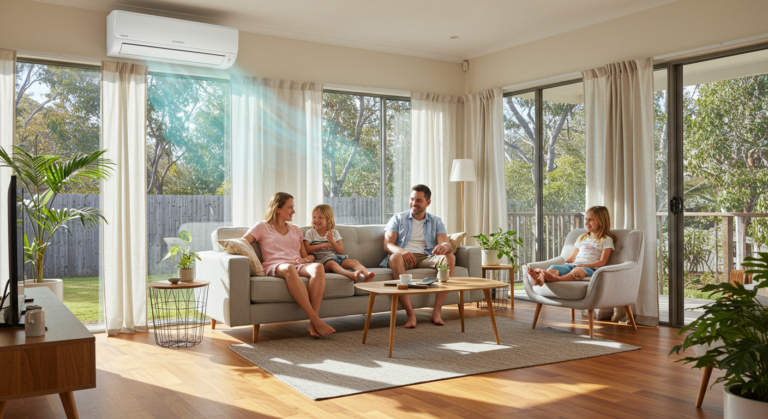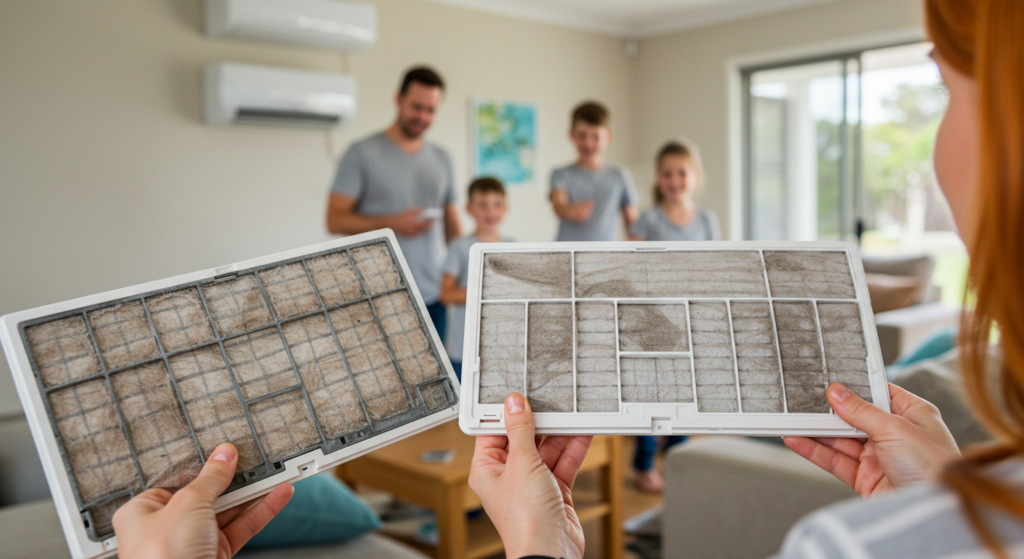
Table of Contents
ToggleWhen the temperature rises, the air conditioner becomes a trusted part of the home. Cool air can turn a hot, restless day into a comfortable one. But if the system is not maintained, problems soon appear. Bills rise, the air feels weak, or the unit stops working when it is needed most.
This guide shares expert advice from Australian government resources, industry standards, and consumer organisations. It is for households that want to keep their systems reliable, efficient, and safe.

Regular air conditioning unit maintenance helps lower energy use and keeps bills under control. Clean filters improve airflow, while blocked ones can raise energy use by up to 15%. For families with asthma or allergies, clean filters also mean better air quality and fewer health risks.
Air conditioning system maintenance also makes units last longer and reduces the chance of sudden breakdowns. With licensed technicians checking for issues like refrigerant leaks, households not only protect their systems but also reduce their environmental impact.
Australia’s varied climate means air conditioning maintenance is not one-size-fits-all. A care calendar helps households prepare for the year.
Before the first heat arrives, filters should be cleaned or replaced. Outdoor units should be cleared of leaves, dust, and cobwebs. This is also a sensible time to book an AC service, so any issues are addressed before peak demand.
In the warmer months, filters may need cleaning every few weeks, especially in dusty or smoky conditions. Outdoor units should be checked often for obstructions. In humid regions, running the fan-only setting for a short time after cooling helps dry the coils and prevents mould.
After summer, clean the unit to remove dust and pollen. For reverse-cycle systems, refresh filters before switching to heating. Set the thermostats between 18 and 20 degrees for warmth. A mid-year service can help in cooler regions to keep heating efficient.
Homeowners can safely handle a few air conditioning maintenance jobs with the power off. First is cleaning the filters. Most units have mesh filters that slide out and can be vacuumed, brushed, or rinsed in warm water with detergent. Once dry, they go back in, and the system works properly again. Wipe the indoor unit with a damp cloth to clear dust from the casing, vents, and louvres so the air stays cleaner.
The outdoor unit needs attention, too. Trimming back plants and clearing away leaves, grass, or dirt stops airflow from being blocked. Switching the system to fan-only mode for a short time after cooling helps dry it out and reduce mould. Look for oil spots or strange noises from the unit. Finding these early can stop small issues from becoming big ones. These simple checks help the system run well between professional services.
Some air conditioning tasks are not safe or legal for homeowners to perform. In Australia, only licensed technicians can carry out this work.
A professional service usually includes testing the thermostat, flushing drains, and deep cleaning coils and fans. Annual servicing is recommended, especially for older or heavily used systems.
Ducted air conditioning maintenance also needs expert care. Ducts can leak or collect dust over time, which lowers efficiency and affects air quality. Licensed technicians check and clean these parts, following standards such as AS/NZS 3666 to keep systems safe. When booking a service, look for the ARCtick symbol to know the technician has the right licence and meets national requirements.
| Timeframe | Tasks |
| Every 2–3 months | Clean filters, dust vents, check and clear the outdoor unit |
| Start of summer & winter | Deep clean indoor unit, reset thermostat, book an AC service if needed |
| Every few years | Inspect ducts, arrange deep cleaning in dusty or humid regions |
| Special conditions | Coastal: treat outdoor coils for salt; Inland: increase filter checks |

Operating habits influence performance and costs.
Caring for an air conditioner is not complicated. Regular filter maintenance, simple inspections, and timely professional services combine to deliver comfort, savings, and healthier air. Following a seasonal schedule and adopting smart usage habits ensures the system runs reliably year after year.
Regular maintenance helps Australian households enjoy cooler summers, warmer winters, and lower bills.
For trusted help with commercial air conditioning maintenance, ducted systems, or residential servicing, visit thacs.com.au for professional support tailored to Australian homes.
Step into a world of ultimate comfort and unmatched energy savings with our custom-designed heating and cooling solutions. Take the first step towards a smarter, greener home—request your free, personalised quote today and embrace the Tailored Difference!
Keeping You in the Loop: Our Latest News, Direct to Your Inbox!